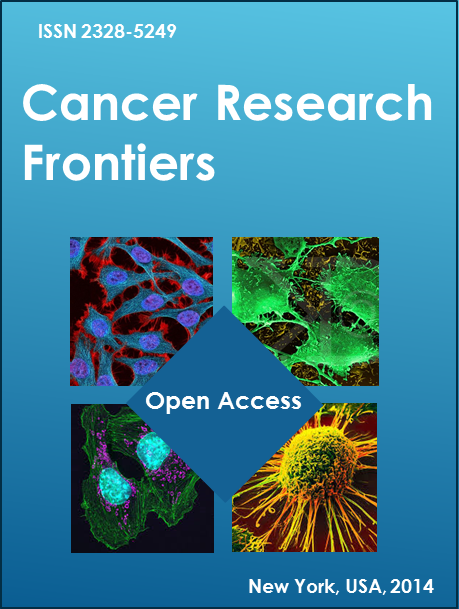Abstract _ Full Text (HTML) _ Full Text (PDF)
RESEARCH ARTICLE
Cancer Research Frontiers 2017; 3(1): 56-63. doi: 10.17980/2017.56
Association between leptin and leptin receptor gene polymorphisms and breast cancer risk in premenopausal and postmenopausal Mexican women
Luz Ma González Huerta1, Carmen I. Santos Cabrera1, Roberto Mociños Montes2, Héctor Urueta Cuellar1, Jaime Toral López 3, Sergio A. Cuevas Covarrubias1*
1Department of Medical Genetics, Hospital General de México/Facultad de Medicina UNAM, México City, México;
2Service of Oncology, Hospital General de México, México City, México;
3Department of Medical Genetics, Centro Medico Ecatepec, ISSEMYM. EdoMex, México.
*Corresponding author: Sergio Cuevas-Covarrubias PhD. Hospital General de México, Universidad Nacional Autónoma de México, Genética, Facultad de Medicina. Dr. Balmis 148, Col. Doctores, CP 06726, Cd. De México, México. Email:
Citation: Luz Ma González Huerta, et al. Association between leptin and leptin receptor gene polymorphisms and breast cancer risk in premenopausal and postmenopausal Mexican women. Cancer Research Frontiers 2017; 3(1): 56-63. doi: 10.17980/2017.56
Copyright: @ 2017 Luz Ma González Huerta, et al. This is an open-access article distributed under the terms of the Creative Commons Attribution License, which permits unrestricted use, distribution, and reproduction in any medium, provided the original author and source are credited.
Competing Interests: The authors declare no competing financial interests.
Received Sept 28, 2016; Revised Jan 10, 2017; Accepted Jan 20, 2017. Published May 15, 2017
Abstract
Purpose: This study aims to evaluate the association between leptin (-2548 G>A) and leptin receptor (p.K109R, p.Q223R, p.K656N) polymorphisms with breast cancer (BC) risk in premenopausal and postmenopausal Mexican women.
Material and methods: 274 women were included, 76 with BC in premenopause, 66 with BC in postmenopause, 108 without BC in premenopause, and 22 without BC in postmenopause. Four polymorphisms were genotyped by PCR, High Resolution Melting, and DNA direct sequencing. χ2, logistic regression analysis was performed with SPSS and XLSTAT software.
Results: There was statistically significant risk of BC in postmenopausal women with LEPR p.Q223R+p.R223R (OR: 8.4, 95% CI: 2.7-25.6, P <0.001), and in premenopausal women with LEP-2548G>A+ -2548A>A genotype (OR: 1.7, 95% CI: 1.0-3.0, P = 0.04).
Discussion and Conclusions: This is the first study from Mexico that includes four polymorphisms on LEP and LEPR genes. Our data indicate that both LEPR p.Q223R in postmenopausal women and LEP-2548G>A in premenopausal women have a strong association with BC, which suggests that these polymorphisms play a role in the development of BC in Mexican women. We detected coincidences and differences with respect to other populations. This highlights the importance of conducting genetic epidemiologic studies to identify the risk of gene polymorphisms and BC for each population.
Keywords: leptin, leptin receptor, breast cancer, premenopause, postmenopause
INTRODUCTION
Breast cancer (BC) is a heterogeneous and complex disease due to an interaction between environmental factors and genetic susceptibility. The major risk factors for developing BC include being of female sex, receiving hormone replacement therapy during menopause, having received ionizing radiation, being of an early age at first menstruation, having children late or none at all, being of older age, having a family history of BC, and being obese (1).Obesity is a well-established risk factor for postmenopausal BC (2) The adipocyte dysfunction in obese individuals stimulates insulin resistance, ineffectual lipolysis, metabolic disease, and the release of mitogenic factors/ proinflammatory cytokines (3).
Leptin, a cytokine of the adipocytes encoded by the leptin (LEP) gene, interacts with the leptin receptor (LEPR), which is present in breast and other tissues (4). LEP and LEPR are overexpressed in BC tissue (5, 6). LEP 2548G>A polymorphism seems to influence leptin mRNA expression in breast cancer cell lines affecting signaling capacity and receptor functionality, increasing the LEPR-LEP binding capacity (7,8). This induces a cascade of events in the tumor microenvironment, causing the proliferation, angiogenesis, and invasion of the cell (9, 10). QR and RR genotypes of the LEPR p.Q223R polymorphism have been associated with modest risk for BC in non-obese premenopausal women (11), whereas QR and QR+QQ genotypes of the LEPR p.Q223R polymorphism with BC in overweight postmenopausal women (12).
The RR genotype of the LEPR p.K109R polymorphism has been associated with large tumors in obese premenopausal women (13). The LEP -2548G>A polymorphism has been associated with modest risk of BC in obese postmenopausal women (14). In a previous study, no statistical differences were found between BC and LEP 2548G>A in obese or non-obese Mexican women (15).
We hypothesize that single nucleotide polymorphisms (SNP), -2548G>A, located in the promoter of the LEP gene, and p.K109R, p.Q223R, p.K656N, located in the coding zone of LEPR gene, could influence BC risk, according to menopausal status (16–20) in Mexican women.
MATERIAL AND METHODS
Patient population
The study included 274 women (mean age of 42.5±10.4 years), 142 with BC (mean age of 47.3±9.1 years), and 132 healthy controls (mean age of 37.3±9.2 years); 184 were premenopausal (mean age of 36.4±6.8 years) and 90 were postmenopausal (mean age of 53.2±5.9 years). The stage of the patients was III according to the breastcancer.org. All of the unrelated subjects were born in Mexico, with at least three generations of Mexican parents. All women resided in metropolitan areas. The protocol was approved by the Ethics Committee of the General Hospital of Mexico. Informed consent was obtained from all subjects. Eating habits, reproductive and menstrual histories, exogenous hormone use, familial history of cancer, physical activity, alcohol and smoking histories, weight in kilograms (Kg), height in meters (m), and body mass index (BMI = Kg/m2) were determined in all subjects.
Genotyping analysis of LEP and LEPR polymorphisms
Genomic DNA was extracted from peripheral blood leukocytes (using the protocol of peripheral blood DNA extraction, Wizard-Promega). Oligonucleotides for the LEP gene, SNP (-2548G>A) were: forward 5’-TTCCTGTAATTTTCCCATGAGAAC-3’ and reverse 5’-TCTCAGCACTTAGGGAGACT-3’; while the oligonucleotides for the SNP in LEPR gene (p.K109R) were: forward 5’-GAAACTGCTCCTTATGTGCAGA-3’ and reverse 5’-TGCTTACCTATTTGT TGAAAAACTAAA-3’; oligonucleotides for the SNP in the LEPR gene (p.Q223R) were: forward 5’-CGACACTCTCCTTATGTG TTTGA-3’ and reverse 5’-ATATTTATGGGGTGAACTGACATTAG-3’; and for the SNP in the LEPR gene (p.K656N) were: forward 5’- GAGGACCTGAATTTTGGAGAATAA-3’ and reverse: 5’-GAATACCTTCCAAAGTAAAGTGACA-3’. The PCR products obtained from the cases/controls were sequenced on an ABI 3730 Automated Sequencer (PE Biosystems, Foster City, CA, USA). Genotyping by PCR and High Resolution Melting (HRM) analyses were done on the LS-32 (Idaho Technology) and analyzed with the software LightScanner Primer Desing, as previously described elsewhere (21, 22).
Statistical analyses
The agreement of genotype frequencies with Hardy-Weinberg equilibrium (HWE) expectations and allelic frequencies were analyzed with the chi-square test (χ2). Binary logistic regression was used to determine OR (odds ratio), 95% confidence interval (CI), and significant differences (P value) of the genotypic frequencies among BC patients and healthy controls, between premenopausal versus postmenopausal women, and among BMI >30 versus BMI< 30. Postmenopausal status was considered by absence of menses for at least 1 year or according to the average of the Mexican population if the record was not obtained (23). For analysis, because patients with the homozygous minor allele or genotype were uncommon in our sample, these patients were included with their respective heterozygotes. This is consistent with analysis techniques reported elsewhere (24, 25). P value <0.05 was considered statistically significant. These analyses were carried out with SPSS (v. 22.0) and XLSTAT (v. 2015) software.
RESULTS
Distribution of genotype and allele frequencies of LEP and LEPR gene polymorphisms
HRM curve and sequencing analysis of the four SNPs in the 274 Mexican women showed heterozygous and homozygous curves, suggesting the presence of allelic variation (Figure 1). HRM variation detection sensitivity was 100% concordant with 274 variations, as confirmed through DNA direct sequencing analysis.
The genotype distribution and allele frequencies of the LEP (-2548 G>A) and LEPR p.K109R, p.Q223R, p.K656N polymorphisms in all patients with BC, and in the healthy controls, are shown in Table 1. The genotype frequencies were in HWE in both patients and healthy controls for LEP (-2548 G>A) (P = 0.32, P = 0.31), LEPR p.Q223R, (P = 0.22, P = 0.40) and LEPR p.K656N (P = 0.75, P = 0.75); there was not Hardy-Weinberg equilibrium for LEPR p.K109R (P = 0.035, P = 0.042).
Figure 1. Melting curve analysis (A and C) and electropherograms of a partial sequence of the (B) LEP (-2548G>A) and (D) LEPR (p.Q223R) gene polymorphisms in the BC patients and healthy controls are showed. Wild-type homozygous, heterozygous and mutant homozygous genotypes are represented by colors different in the melting curves. The black arrows show the SNPs sites in the electropherograms. Abbreviations: R, Arginine; Q, glutamine.
Table 1 Genotypic and allelic frequency of LEP and LEPR polymorphisms and their associations with risks of breast cancer (BC) in patients with BC and healthy controls
Association between LEP and LEPR polymorphisms with overall BC risk
Analyses to determine the association of LEP and LEPR polymorphisms with overall BC risk indicated statistical differences (p<0.05) with low OR in patients with BC, and in carriers of LEPR 109KR+RR and LEPR 223QR+RR genotypes. No statistical differences were observed for LEP (-2548G>A) and for LEPR p.K656N polymorphisms (Table 1).
Association between LEP and LEPR polymorphism with BC risk according menopausal status
Analyses of stratification of the premenopausal and postmenopausal patients to detect BC risk showed statistical differences for the LEPR 223QR+RR genotype, with a higher BC risk in postmenopausal women (OR: 8.4, 95% CI: 2.7-25.6, P < 0.001, whereas the LEP-2548 GA+AA genotype indicated statistical differences with a higher risk of BC in premenopausal women (OR: 1.7, 95% CI: 1.0-3.0, P = 0.04). No risk was observed with the remaining LEP and LEPR gene polymorphisms and BC (Table 2).
When we added the condition of BMI> 30 or BMI <30 into the analysis, in addition to the menopausal status, we observed a higher risk of BC in postmenopausal women, predominantly in those with BMI>30 (OR 4.5 95% CI: 2.1-9.5, P <0.001) versus BMI<30 (OR 2.6 95% CI: 1.2-5.7, P= 0.015) (Table 3).
Cumulative analyses of the studied polymorphisms showed that LEP -2548, LEPR 326 y LEPR 668 have higher risk for BC (OR: 9.0, 95% CI 2.48-32-5, P = 0.001) (Table 4).
Table 2. Genotypic frequency distribution of LEP and LEPR Polymorphisms and BC risk according at menopausal status
Table 3. Breast cancer risk according at menopausal status and BMI status
Table 4. Cumulative effect of LEP and LEPR polymorphisms and breast cancer risk.
DISCUSSION
In this study, LEPR p.Q223R (QR+RR) established a statistical difference with a high OR for BC in postmenopausal women, and LEP -2548G>A (GA+AA) had a statistical difference with a higher OR in premenopausal women with BC. These data show the involvement of LEP and LEPR gene polymorphisms in BC risk in the Mexican population. Contrary to a previous study in Mexican patients (15), our study detected a higher risk of BC in postmenopausal women with a BMI>30, suggesting obesity contributes significantly to the risk of BC in postmenopausal women, but not in premenopausal women (Table 3). This could be due to a bias in the sample selection in the previous Mexican study.
In other populations, the LEPR p.K109R polymorphism has been associated with BC risk in obese premenopausal women (13); however, a meta-analysis suggested that the LEP p.K109R polymorphism did not affect risk of BC (26). LEPR p.Q223R and LEP -2548G>A polymorphisms have been associated with BC in obese postmenopausal women (18,19), whereas LEPR p.Q223R and p.R223R polymorphisms are associated with BC in non-obese premenopausal women (14). Conversely, in our Mexican sample, LEPR p.Q223R was associated with BC in postmenopausal women; this demonstrates the importance of conducting these studies in several populations.
Five out of ten studies reported an association between the LEPR p.Q223R polymorphism with BC risk. In one of them, p.Q223R and p.R223R were associated with an increased BC risk and with shorter overall survival (16). Other studies reported an association between p.R223R with luminal A subtype of BC (19), and tumor grade of BC (26), with poorly differentiated BC (20). In the present study, LEPR p.Q223R + p.R223R were associated with BC in obese postmenopausal women. Conversely, four studies showed no risk of BC with LEPR p.Q223R/p.R223R (14, 17, 27, 28), emphasizing the importance of the relationship between genetic backgrounds with environmental/epigenetic factors.
On the other hand, the LEP (-2548G>A) polymorphism has been analyzed in ten studies; in two of them, the A allele was associated with BC (16, 18, 29). Seven studies showed no association between BC and the LEP -2548G>A polymorphism (9, 17-19, 27, 28). In our population, we found statistical differences in the LEP (-2548G>A) (GA+AA) polymorphism and BC in premenopausal women.
Breast cancer is a complex and multifactorial disease, and gen-gene and gene-environmental interactions may contribute significantly to its occurrence (30). Many non-infectious diseases are polygenic and involve polymorphisms that predispose people to obesity, glucose intolerance, insulin resistance, and a higher risk of developing BC (14). Major risk factors for BC and linkage disequilibrium of LEP and LEPR polymorphisms in each population play a role in BC risk (12, 17, 18, 27, 28). In our study, the combination of LEP -2548, LEPR p.K109R, and LEPR p.Q223R polymorphisms have a higher risk for BC with OR of 9.0, 95% CI 2.48-32-5, P = 0.001) (Table 4). This demonstrates the cumulative effect of the gene-gene interaction and the complexity of determining the BC risk (31, 32).
The postmenopausal state involves hormonal changes such as decreases in estrogen. The importance of the LEP and LEPR gene polymorphisms in BC could be explained by the changes in the expression levels of leptin, with the effect on leptin receptors possibly at the transcriptional level (20, 33). These changes stimulate the production of estrogen through the increase of aromatase expression in the cells of BC (34). Further studies of BC risk in several populations are necessary due to the different genetic background of each population.
In conclusion, we detected an association between LEP (-2548G>A) and BC in premenopausal women and LEPR p.Q223R with BC in obese postmenopausal women, which indicates that these polymorphisms play a role in the development of BC in Mexican women. One limitation of the present study is perhaps the sample size, even though there were statistical differences probably a larger sample could be a better indicator. We detected coincidences and differences with respect to other populations.
ACKNOWLEDGMENTS
We thank the patients for participating in this study and the DGAPA-PAPIIT UNAM (grant IN204114-2) from the National Autonomous University of Mexico (UNAM) for financial support.
ABBREVIATIONS
BC, breast cancer;
BMI, body mass index;
CI, confidence interval;
HC, healthy controls;
HRM, high resolution melting;
LEP, leptin;
LEPR, leptin receptor;
OR, odds ratio;
P, patients with breast cancer;
PCR, polymerase chain reaction;
REFERENCES
- Steward BW, Wild CP, Wild C. Cancer etiology. Word cancer report. World health Organization. International Agency for Research on Cancer, Lyon; 2014. p. 82-169.
- See comment in PubMed Commons belowMcPherson K, Steel CM, Dixon JM. ABC of breast diseases. Breast cancer-epidemiology, risk factors, and genetics. BMJ. 2000 Sep 9;321(7261):624-8. doi: 10.1136/bmj.321.7261.624.
- Ibrahim MM. Subcutaneous and visceral adipose tissue: structural and functional differences. Obes Rev 2010 Jan;11(1):11–18. doi: 10.1111/j.1467-789X.2009.00623.x.
- Mantzoros CS, Moschos SJ. Leptin: in search of role(s) in human physiology and pathophysiology. Clin Endocrinol (Oxf). 1998 Nov;49(5):551-67. doi: 10.1046/j.1365-2265.1998.00571.x.
- Hu X, Juneja SC, Maihle NJ, Cleary MP. Leptin a growth factor in normal and malignant breast cells and for normal mammary gland development. J Natl Cancer Inst. 2002 Nov 20;94(22):1704-11. doi: 10.1093/jnci/94.22.1704.
- Vona-Davis L, Howard-McNatt M, Rose DP. Adiposity, type 2 diabetes and the metabolic syndrome in breast cancer. Obes Rev. 2007 Sep;8(5):395-408. doi: 10.1111/j.1467-789X.2007.00396.x.
- Terrasi M, Fiorio E, Mercanti A, Koda M, Moncada CA, Sulkowski S, et al. Functional analysis of the -2548G/A leptin gene polymorphism in breast cancer cells. Int J Cancer. 2009 Sep 1;125(5):1038-44. doi: 10.1002/ijc.24372.
- Mohammadzadeh G, Ghaffari MA, Bafandeh A, Hosseini SM. Effect of leptin receptor Q223R polymorphism on breast cancer risk. Iran J Basic Med Sci. 2014 Aug;17(8):588-94.
- Jarde T, Perrier S, Vasson MP, Caldefie-Chezet F. Molecular mechanisms of leptin and adiponectin in breast cancer. Eur J Cancer. 2011 Jan;47(1):33-43. doi: 10.1016/j.ejca.2010.09.005.
- Andò S, Catalano S. The multifactorial role of leptin in driving the breast cancer microenvironment. Nat Rev Endocrinol. 2011 Nov 15;8(5):263-75. doi: 10.1038/nrendo.2011.184.
- Okobia MN, Bunker CH, Garte SJ, Zmuda JM, Ezeome ER, Anyanwu SN, et al. Leptin receptor Gln223Arg polymorphism and breast cancer risk in Nigerian women: a case control study. BMC Cancer. 2008 Nov 18;8:338. doi: 10.1186/1471-2407-8-338.
- Ulybina YM, Imyanitov EN, Vasilyev DA, Berstein LM. Polymorphism of glucose intolerance and insulin resistance susceptibility genes in oncological patients. Mol Biol (Mosk). 2008 Nov-Dec;42(6):947-56.
- Liu CL, Chang YC, Cheng SP, Chern SR, Yang TL, Lee JJ. The roles of serum leptin concentration and polymorphism in leptin receptor gene at codon 109 in breast cancer. Oncology. 2007;72(1-2):75-81. doi: 10.1159/000111097.
- Cleveland RJ, Gammon MD, Long CM, Gaudet MM, Eng SM, Teitelbaum SL, et al. Common genetic variations in the LEP and LEPR genes, obesity and breast cancer incidence and survival. Breast Cancer Res Treat. 2010 Apr;120(3):745-52. doi: 10.1007/s10549-009-0503-1.
- Garcia-Robles MJ, Danari-Navarro A, del Toro-Arreola S, Fafutis-Morris M The LEP G-2548A polymorphism is not associated with breast cancer susceptibility in obese western Mexican women. J Clin Cell Immunol. 2013;4:133. doi: 10.4172/2155-9899.1000133.
- Snoussi K, Strosberg AD, Bouaouina N, Ben Ahmed S, Helal AN, Chouchane L. Leptin and leptin receptor polymorphisms are associated with increased risk and poor prognosis of breast carcinoma. BMC Cancer. 2006 Feb 20;6:38. doi: 10.1186/1471-2407-6-38.
- Gallicchio L, McSorley MA, Newschaffer CJ, Huang HY, Thuita LW, Hoffman SC, et al. Body mass, polymorphisms in obesity-related genes, and the risk of developing breast cancer among women with benign breast disease. Cancer Detect Prev. 2007;31(2):95-101. doi: 10.1016/j.cdp.2007.02.004.
- Han CZ, Du LL, Jing JX, Zhao XW, Tian FG, Shi J, et al. Associations among lipids, leptin, and leptin receptor gene Gin223Arg polymorphisms and breast cancer in China. Biol Trace Elem Res. 2008 Winter;126(1-3):38-48. doi: 10.1007/s12011-008-8182-z.
- Nyante SJ, Gammon MD, Kaufman JS, Bensen JT, Lin DY, Barnholtz-Sloan JS, et al. Common genetic variation in adiponectin, leptin, and leptin receptor and association with breast cancer subtypes. Breast Cancer Res Treat. 2011 Sep;129(2):593-606. doi: 10.1007/s10549-011-1517-z.
- Gu F, Kraft P, Rice M, Michels KB. Leptin and leptin receptor genes in relation to premenopausal breast cancer incidence and grade in Caucasian women. Breast Cancer Res Treat. 2012 Jan;131(1):17-25. doi: 10.1007/s10549-011-1778-6.
- Liew M, Pryor R, Palais R, Meadows C, Erali M, Lyon E, et al. Genotyping of single-nucleotide polymorphisms by high-resolution melting of small amplicons. Clin Chem. 2004 Jul;50(7):1156-64. doi: 10.1373/clinchem.2004.032136.
- González-Huerta LM, Messina-Baas O, Urueta H, Toral-López J, Cuevas-Covarrubias SA. A CRYGC gene mutation associated with autosomal dominant pulverulent cataract. Gene. 2013 Oct 15;529(1):181-5. doi: 10.1016/j.gene.2013.07.044.
- Garrido-Latorre F, Lazcano-Ponce EC, López-Carrillo L, Hernández-Avila M. Age of natural menopause among women in Mexico City. Int J Gynaecol Obstet. 1996 May;53(2):159-66. doi: http://dx.doi.org/10.1016/0020-7292(96)02655-0.
- Bengtsson K, Melander O, Orho-Melander M, Lindblad U, Ranstam J, Råstam L, et al. Polymorphism in the beta-1-adrenergic receptor gene and hypertension. Circulation. 2001 Jul 10;104(2):187-90. doi: http://dx.doi.org/10.1161/01.CIR.104.2.187.
- Schwartz SG, Puckett BJ, Allen RC, Castillo IG, Leffler CT. Beta1-adrenergic receptor polymorphisms and clinical efficacy of betaxolol hydrochloride in normal volunteers. Ophthalmology. 2005 Dec;112(12):2131-6. doi: 10.1016/j.ophtha.2005.08.014.
- Shi H, Shu H, Huang C, Gong J, Yang Y, Liu R, et al. Association of LEPR K109R polymorphisms with cancer risk: a systematic review and pooled analysis. J BUON. 2014 Jul-Sep;19(3):847-54.
- Woo HY, Park H, Ki CS, Park YL, Bae WG. Relationships among serum leptin, leptin receptor gene polymorphisms, and breast cancer in Korea. Cancer Lett. 2006 Jun 8;237(1):137-42. doi: 10.1016/j.canlet.2005.05.041.
- Teras LR, Goodman M, Patel AV, Bouzyk M, Tang W, Diver WR, et al. No association between polymorphisms in LEP, LEPR, ADIPOQ, ADIPOR1, or ADIPOR2 and postmenopausal breast cancer risk. Cancer Epidemiol Biomarkers Prev. 2009 Sep;18(9):2553-7. doi: 10.1158/1055-9965.EPI-09-0542.
- Yan W, Ma X, Gao X, Zhang S. Association between leptin (-2548G/A) genes polymorphism and breast cancer susceptibility: a meta-Analysis. Medicine (Baltimore). 2016 Jan;95(4):e2566. doi: 10.1097/MD.0000000000002566.
- He J, Xi B, Ruiter R, Shi TY, Zhu ML, Wang MY, et al. Association of LEP G2548A and LEPR Q223R polymorphisms with cancer susceptibility: evidence from a meta-analysis. PLoS One. 2013 Oct 17;8(10):e75135. doi: 10.1371/journal.pone.0075135.
- Sun J, Chang BL, Isaacs SD, Wiley KE, Wiklund F, Stattin P, et al. Cumulative effect of five genetic variants on prostate cancer risk in multiple study populations. Prostate. 2008 Sep 1;68(12):1257-62. doi: 10.1002/pros.20793.
- Vogelsang M, Wang Y, Veber N, Mwapagha LM, Parker MI. The cumulative effects of polymorphisms in the DNA mismatch repair genes and tobacco smoking in oesophageal cancer risk. PLoS One. 2012;7(5):e36962. doi: 10.1371/journal.pone.0036962.
- Hoffstedt J, Eriksson P, Mottagui-Tabar S, Arner P. A polymorphism in the leptin promoter region (-2548 G/A) influences gene expression and adipose tissue secretion of leptin. Horm Metab Res. 2002 Jul;34(7):355-9. doi: 10.1055/s-2002-33466.
- Catalano S, Marsico S, Giordano C, Mauro L, Rizza P, Panno ML, et al. Leptin enhances, via AP-1, expression of aromatase in the MCF-7 cell line. J Biol Chem. 2003 Aug 1;278(31):28668-76. doi: 10.1074/jbc.M301695200.













